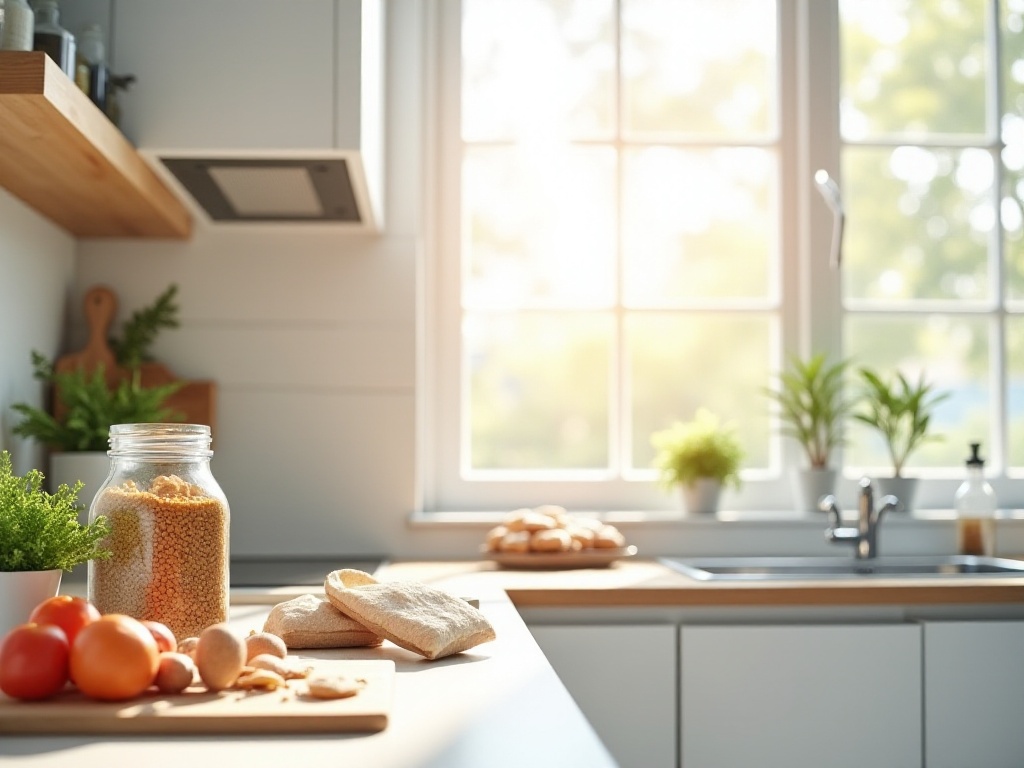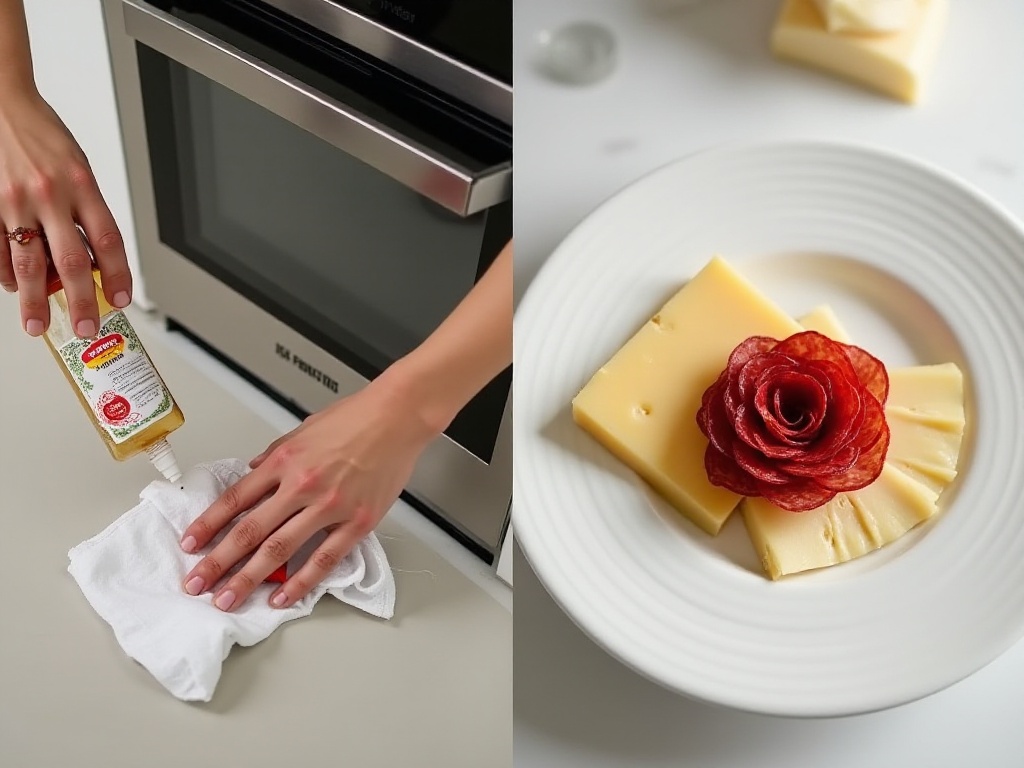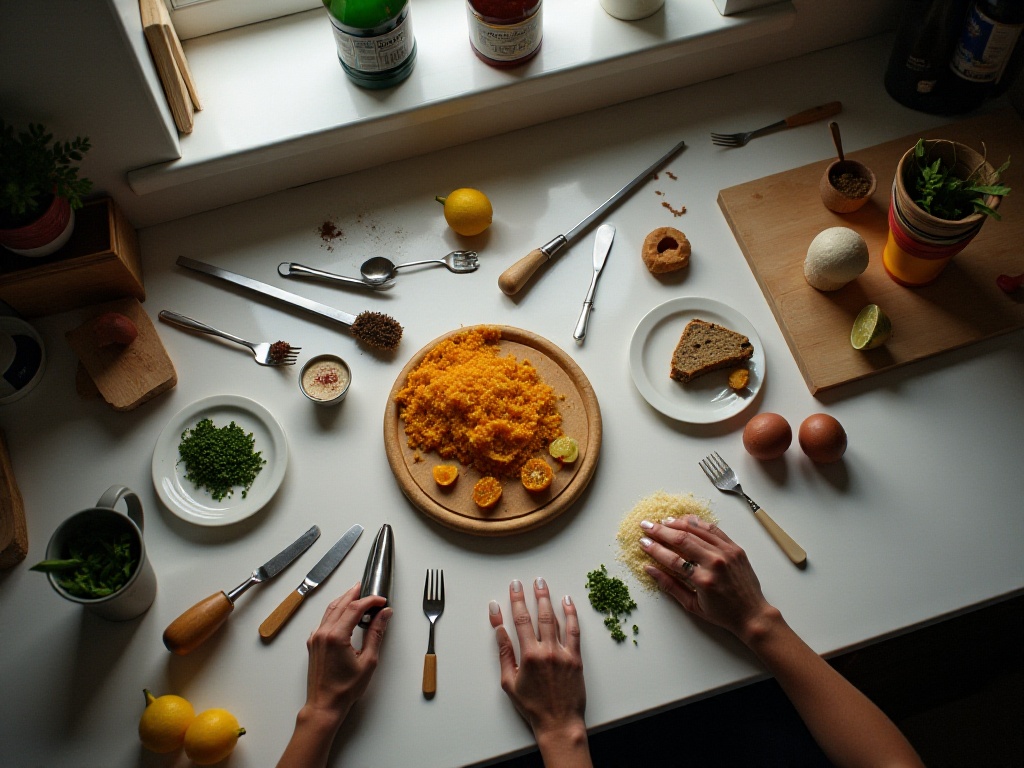
Introduction
Are you often troubled by kitchen cleaning? After cooking, you face a pile of dirty pots and pans, greasy stovetops, and that hard-to-clean oven. As someone who loves cooking but hates cleaning up, I can totally relate. Don't worry - today I'll share some super practical kitchen cleaning tips that will keep your kitchen spotless. After years of exploration and practice, I've finally found a set of effective methods that are simple, cost-effective, and use everyday household items. These methods have helped me keep my kitchen in perfect order, and I believe they'll be helpful for you too.
Ingredient Handling
When it comes to the kitchen, ingredient handling might be the most headache-inducing part. Each ingredient has its characteristics and requires different handling methods to be efficient. For example, have you encountered peanut butter with oil on top and rock-hard paste below? Many people try to stir it vigorously with a spoon, but this is not only laborious but also messy. There's actually a simple solution: turn the peanut butter jar upside down for 15 minutes, then turn it back and stir gently - this will make the peanut butter smooth and uniform. This method uses gravity to naturally let the oil permeate the peanut butter, saving time and effort while keeping your hands clean.
Cheese cutting is also a skill. Traditional cutting methods often result in cheese sticking to the knife, making a mess. I discovered that dental floss is perfect for cutting cheese, especially soft cheeses. Just pull the floss taut and gently slice through the cheese block for perfect slices. Using floss ensures uniform thickness, ideal for plating or making sandwiches. For hard cheese, I recommend letting it sit at room temperature for about 15-20 minutes before cutting, making it slightly softer and easier to cut.
For herbs, many people pick leaves one by one, which is time-consuming and tedious. Actually, you can just pull herb stems backwards through a colander's hole, and all leaves will fall off instantly. When I first tried this trick, I was amazed - it's at least ten times more efficient. This method works well for various herbs, whether thyme, rosemary, or mint leaves. The picked leaves can be used immediately or dried for storage. I usually store extra herb leaves in sealed bags in the refrigerator, keeping them fresh for up to a week.
When handling garlic, many find peeling tedious. Simply place the whole head of garlic between two bowls and shake vigorously for about 30 seconds, and the cloves will separate from their skins. This method is not only quick but can process large amounts of garlic at once, perfect for dishes requiring lots of garlic. Peeled garlic can be used immediately or stored in a sealed container in the refrigerator, though it's best used within a week.
Ginger is another common but tricky ingredient to handle. Many people cut it directly with a knife, but this can be wasteful and result in uneven pieces. I found using a teaspoon to scrape ginger is very convenient - it easily removes the skin and creates uniform ginger paste. This method is perfect for making sauces or marinating ingredients. Leftover ginger should be wrapped in plastic wrap and refrigerated for longer storage.

Cleaning Tips
The grease on oven doors can be really frustrating, seeming impossible to clean no matter how hard you scrub. I recently discovered a great method: make a paste with baking soda and white vinegar, apply it to the oven door, let it sit for 20 minutes, then wipe with a damp cloth. You won't believe how easily those stubborn grease stains come off. This method works because baking soda provides gentle abrasion while vinegar's acidity breaks down grease. Together, they effectively clean without damaging the oven surface. For particularly stubborn stains, you can extend the waiting time to 30 minutes or repeat the process several times. After cleaning, it's recommended to wipe several times with a clean damp cloth to ensure all cleaner residue is removed.
What about burnt pot bottoms? Don't rush to scrub with steel wool. I suggest pouring some water into the pot, adding a lemon slice, bringing it to a boil, then simmering for 15 minutes. Once the water cools, you'll find those black marks have loosened and can be easily wiped away with a sponge. This method utilizes lemon's natural acidity to effectively soften burnt residue without leaving chemical cleaner odors. If you don't have lemon, white vinegar works well too. This method is especially effective for stainless steel cookware, but note that it may not be suitable for cast iron pots and some specially coated cookware.
Microwave interior grease is another common cleaning challenge. I found a simple solution: place a cut lemon and two cups of water in a microwave-safe bowl, then heat on high for 3-5 minutes. The generated steam will soften stubborn stains, making them easy to wipe clean with paper towels. This method is not only eco-friendly but also deodorizes the microwave - two birds with one stone. After cleaning, it's recommended to leave the microwave door open for a few minutes to let the interior dry completely, preventing bacteria growth.
Sink cleaning and maintenance are also important. Stainless steel sinks often develop water spots and small scratches, making the whole kitchen look messy. My approach is to first sprinkle baking soda on the sink surface, then use half a lemon dipped in baking soda to scrub the entire sink. This not only removes water spots but also restores the sink's shine. Finally, rinse with clean water and dry with a soft cloth. To prevent rust, it's recommended to wipe dry after each use and perform this deep cleaning regularly.
Range hood cleaning is another big task. Many find it particularly challenging, but it's not difficult with the right method. First, remove the filters and soak them in hot water with dish soap and baking soda for 30 minutes. Then gently scrub with a soft brush and rinse clean. For the hood exterior, wipe with warm soapy water and dry with a clean cloth. It's recommended to clean the filters every two weeks to maintain filtering effectiveness and extend service life.

Storage Tips
Refrigerator organization has always been challenging, especially with freezer bags being messy and taking up space while being hard to find. I now use a particularly practical method: fold freezer bags neatly by category and store them vertically in standing file organizers. This not only saves space but makes retrieval very convenient. For better frozen food management, I label each bag with the ingredient name and freezing date to avoid keeping food too long. Additionally, I designate different areas in the refrigerator for different types of ingredients, such as meat, seafood, and vegetables, making everything easy to find.
Spice storage is also key. I keep frequently used spices on a rotating organizer, making them easy to access without cluttering the counter. For less frequently used spices, I store them in small sealed jars in a drawer, labeled with contents and purchase dates. This maintains spice freshness while keeping track of inventory.
Kitchen utensil storage requires proper methods too. I keep frequently used cookware and tableware in easily accessible locations, while less frequently used items go in higher or lower cabinets. For irregularly shaped utensils like spatulas and ladles, I use hooks on the wall, saving space while keeping them handy. Knives are best stored in dedicated knife blocks or magnetic strips to maintain sharpness and ensure safety.
Here's a recent party tip I discovered: cut 2L beverage bottles in half, use the bottom for chips and the inverted top for dips - it's eco-friendly, practical, and prevents direct hand contact with food. This idea works well for both home gatherings and outdoor activities. Just make sure to thoroughly clean the bottles first, preferably using clear bottles for better appearance.
For frequently used small items like measuring spoons and bottle openers, I keep them together in a small basket that can be taken out when needed and returned afterward. This keeps things convenient while maintaining drawer organization. When storing these small items, it's best to categorize them by frequency of use and function for easier access.

Clothing Care
Have you ever accidentally gotten paint on your clothes? Many people's first reaction is to throw them away. Actually, you can apply white vinegar to the back of the fabric, gently scrub with a toothbrush, then soak in warm water for 30 minutes to remove most paint stains. I successfully saved a white T-shirt using this method just last week. When treating such stains, make sure to first check if the fabric is suitable for vinegar treatment - for some special materials, it's best to test on an inconspicuous area first.
Oil stains are another common problem, especially when working in the kitchen. When this happens, immediately absorb surface oil with kitchen paper, then sprinkle talcum powder or cornstarch to absorb remaining oil. After 15-20 minutes, brush off the powder and wash normally. This method is particularly effective for fresh oil stains, though older stains may require several repetitions for complete removal.
Fruit juice stains can also be tricky. If juice splashes on clothing, immediately rinse with cold water, then treat with a dedicated stain remover. If no stain remover is available, a mixture of lemon juice and salt can be used as a substitute - apply to the stain, gently rub, then rinse with cold water. This method works especially well for light-colored clothing but should be used cautiously on dark colors as lemon juice may cause fading.
For those annoying label adhesive residues, use a hair dryer to heat the area, then gently wipe with olive oil for easy removal. I've used this method many times with great results. Heat softens the adhesive while olive oil dissolves it. Remember to wash off the oil afterward to prevent staining. If olive oil isn't available, other cooking oils work well too.
Different types of clothing require different washing methods. Cotton garments are generally more washable and can use standard washing methods. However, delicate fabrics like silk and wool need special attention. These should be washed with mild detergents in not-too-hot water, avoiding vigorous rubbing. It's best to dry them flat to maintain shape.
For those who frequently work in the kitchen, it's recommended to have dedicated kitchen work clothes. Choose materials that are easy to clean and durable, so you won't worry too much about stains. Wearing an apron is also a good way to protect clothing, especially when handling ingredients that might splash.

Practical Advice
While these tips seem simple, attention to detail is needed for them to work effectively. For example, when cleaning with baking soda and vinegar, it's recommended to test on a small area first to ensure no surface damage. When handling clothes, pay attention to water temperature as high temperatures may damage fabrics. In practice, adjust methods and quantities according to specific situations.
Choosing cleaning tools is also important. Different cleaning tasks require different tools - soft brushes are suitable for delicate surfaces while hard brushes are better for stubborn stains. Clean tools promptly after use and air dry them to extend their lifespan and maintain hygiene.
Time management is another key factor. It's recommended to create a cleaning schedule, allocating different cleaning tasks to different time slots. For example, handle dishes and countertops immediately after cooking, with deep cleaning scheduled for weekends. This prevents buildup of dirt and makes cleaning work easier.
When using cleaning products, pay attention to safety. Some cleaners shouldn't be mixed as they may produce harmful gases. Also, wear gloves when using cleaners to protect your hands from irritation. Ensure good ventilation after cleaning to disperse cleaner odors.
For special materials like wooden cutting boards and cast iron cookware, use specific care methods. Clean wooden cutting boards promptly and dry them thoroughly, regularly treating with food-grade oil. Cast iron cookware should avoid prolonged soaking and needs oil coating after use to prevent rust.

Summary and Outlook
Through these tips, we can transform tedious housework into something easy and interesting. Have you noticed that solving life's problems often doesn't require complicated methods - the key is finding the right approach? These tips come from life wisdom and mostly use readily available items.
By practicing these methods, we can develop better living habits. For instance, dealing with stains promptly makes cleaning easier and extends item lifespan. Meanwhile, these eco-friendly cleaning methods reduce chemical cleaner use, being more environmentally friendly.
As living standards rise, people's expectations for home environments keep increasing. A clean kitchen not only makes cooking more enjoyable but provides a healthy living environment for family. These cleaning tips and storage methods help us better manage housework while having more time to enjoy life.
After sharing all this, would you like to try these methods? Or do you have unique life tips to share? Welcome to tell me in the comments section, let's make life easier together.
After all, life should be simple and beautiful, right? Let's use these little wisdoms to fill each day with sunshine.

Next
Starting from a Tang Yuan: Do You Really Understand the Chinese Wisdom in the Lantern Festival?
Explore Chinese traditional festival customs and life wisdom, covering cultural activities, food traditions, and celebrations of Spring Festival, Dragon Boat Festival, Lantern Festival, and Mid-Autumn Festival, along with practical tips for improving life efficiency and home organization
Ten Years as a Working Professional: 14 Kitchen Storage Tips to Double Your Kitchen Space
A comprehensive guide exploring life hacks and festival customs, covering practical home organization tips, kitchen techniques, and traditional customs exemplified through Chinese New Year celebrations and cultural heritage practices
No More Kitchen Cleaning Struggles! These Practical Tips Will Make Your Kitchen Look Brand New
A comprehensive guide to practical life hacks and traditional festival customs, covering kitchen techniques, cleaning methods, clothing care, storage tips, and cultural practices of traditional festivals like Mid-Autumn Festival and Lantern Festival
Next

Starting from a Tang Yuan: Do You Really Understand the Chinese Wisdom in the Lantern Festival?
Explore Chinese traditional festival customs and life wisdom, covering cultural activities, food traditions, and celebrations of Spring Festival, Dragon Boat Festival, Lantern Festival, and Mid-Autumn Festival, along with practical tips for improving life efficiency and home organization

Ten Years as a Working Professional: 14 Kitchen Storage Tips to Double Your Kitchen Space
A comprehensive guide exploring life hacks and festival customs, covering practical home organization tips, kitchen techniques, and traditional customs exemplified through Chinese New Year celebrations and cultural heritage practices

No More Kitchen Cleaning Struggles! These Practical Tips Will Make Your Kitchen Look Brand New
A comprehensive guide to practical life hacks and traditional festival customs, covering kitchen techniques, cleaning methods, clothing care, storage tips, and cultural practices of traditional festivals like Mid-Autumn Festival and Lantern Festival

